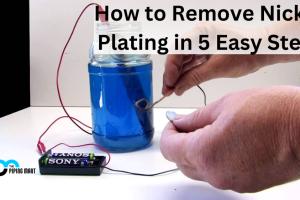Ultimate Guide to Cleaning Nickel Plating: Tips & Techniques

-
Quick Links:
- Introduction
- Understanding Nickel Plating
- Why Clean Nickel Plating?
- Tools and Materials Needed
- Step-by-Step Cleaning Guide
- Tips for Maintaining Nickel Plating
- Common Issues and Solutions
- Case Studies
- Expert Insights
- FAQs
Introduction
Nickel plating is a popular metal finishing process that offers corrosion resistance, improved appearance, and enhanced durability. However, over time, nickel-plated surfaces can become tarnished, stained, or dulled due to various environmental factors and usage. Cleaning nickel plating is essential to restore its original luster and prolong the life of the finish.
Understanding Nickel Plating
Nickel plating involves depositing a layer of nickel onto a metal surface, which can be achieved through electroplating or electroless plating methods. The nickel coating serves multiple purposes, including:
- Corrosion resistance
- Improved wear resistance
- Aesthetic appeal
- Electrical conductivity
This section will explore the different types of nickel plating and their applications.
Types of Nickel Plating
- Electroplated Nickel: Achieved through an electrolytic process, resulting in a thicker and more uniform coating.
- Electroless Nickel: A chemical process that deposits nickel without the use of electricity, often leading to a more even coating.
Why Clean Nickel Plating?
Cleaning nickel plating is crucial for several reasons:
- Maintain Appearance: Nickel plating can lose its shine due to tarnishing and dirt accumulation.
- Prevent Corrosion: Regular cleaning helps prevent corrosion and extends the life of the plating.
- Enhance Performance: Clean nickel surfaces perform better, especially in electrical applications.
Tools and Materials Needed
Before you start cleaning nickel plating, gather the necessary tools and materials:
- Soft cloths or microfiber towels
- Non-abrasive cleaning solution (such as dish soap or a specialized metal cleaner)
- Water
- Soft-bristled brush (optional)
- Protective gloves
Step-by-Step Cleaning Guide
Follow these steps to clean your nickel-plated items effectively:
Step 1: Prepare the Cleaning Solution
Mix a few drops of a non-abrasive cleaner with warm water in a bowl.
Step 2: Wipe Down the Surface
Use a soft cloth dipped in the solution to gently wipe down the nickel-plated surface. Avoid using abrasive materials that could scratch the finish.
Step 3: Rinse and Dry
After cleaning, rinse the surface with clean water to remove any residue, then dry it thoroughly with a clean, soft towel.
Step 4: Inspect for Stains
If you notice any stubborn stains, use a soft-bristled brush to gently scrub the area.
Tips for Maintaining Nickel Plating
To keep your nickel plating looking its best, consider these maintenance tips:
- Avoid exposure to harsh chemicals and cleaners.
- Regularly dust and wipe the surface to prevent buildup.
- Store nickel-plated items in a dry place to reduce moisture exposure.
Common Issues and Solutions
Understanding common problems with nickel plating can help you address them efficiently:
Tarnishing
Tarnishing occurs due to exposure to air and moisture. Regular cleaning can help prevent this.
Scratches and Dullness
Use non-abrasive cleaners and soft cloths to prevent scratching and maintain shine.
Case Studies
Here are a couple of examples of successful nickel plating cleaning projects:
Case Study 1: Restoring Vintage Nickel-Plated Fixtures
A homeowner restored their vintage nickel-plated fixtures by following the cleaning guide, resulting in a beautiful restoration without the need for re-plating.
Case Study 2: Maintaining Industrial Nickel-Plated Parts
A factory implemented a regular cleaning schedule for their nickel-plated machinery, significantly reducing corrosion and prolonging equipment life.
Expert Insights
We consulted with metal finishing experts, who emphasized the importance of using gentle cleaning methods and regular maintenance to ensure the longevity of nickel plating.
FAQs
1. Can I use vinegar to clean nickel plating?
While vinegar is a natural cleaner, it can be too acidic for nickel plating. It's best to stick to a mild soap solution.
2. How often should I clean nickel-plated items?
Regular cleaning every few months is recommended, or more frequently for items in high-use areas.
3. Will using a scrub brush damage nickel plating?
A soft-bristled brush can be used carefully, but avoid abrasive brushes to prevent scratches.
4. Is it safe to use commercial cleaners on nickel plating?
Check the label to ensure the cleaner is non-abrasive and safe for metal surfaces.
5. How do I remove rust from nickel plating?
Use a rust remover specifically designed for metal, but test it on a small area first.
6. Can I restore tarnished nickel plating?
Yes, cleaning and polishing can often restore tarnished nickel plating to its original shine.
7. What should I avoid when cleaning nickel plating?
Avoid abrasive materials, harsh chemicals, and prolonged exposure to moisture.
8. How can I prevent future tarnishing of nickel plating?
Regular cleaning and storing items in a dry, cool place can help prevent tarnishing.
9. Can I use polishing compounds on nickel plating?
Use non-abrasive polishing compounds sparingly; excessive use can wear down the nickel layer.
10. Is professional cleaning recommended for heavily tarnished items?
For heavily tarnished or valuable items, consider seeking professional cleaning services.
Random Reads
- How to get hitmontop pokemon firered
- How to get celebi in pokemon crystal gold silver
- How to get awaken use dough fruit blox fruits
- How to fill a bean bag chair
- How to fill large holes in wood
- How to fill a log book
- How to uninstall mcafee total protection
- How to use microsoft word
- How to use mega cloud storage
- How to fix leaky sink trap